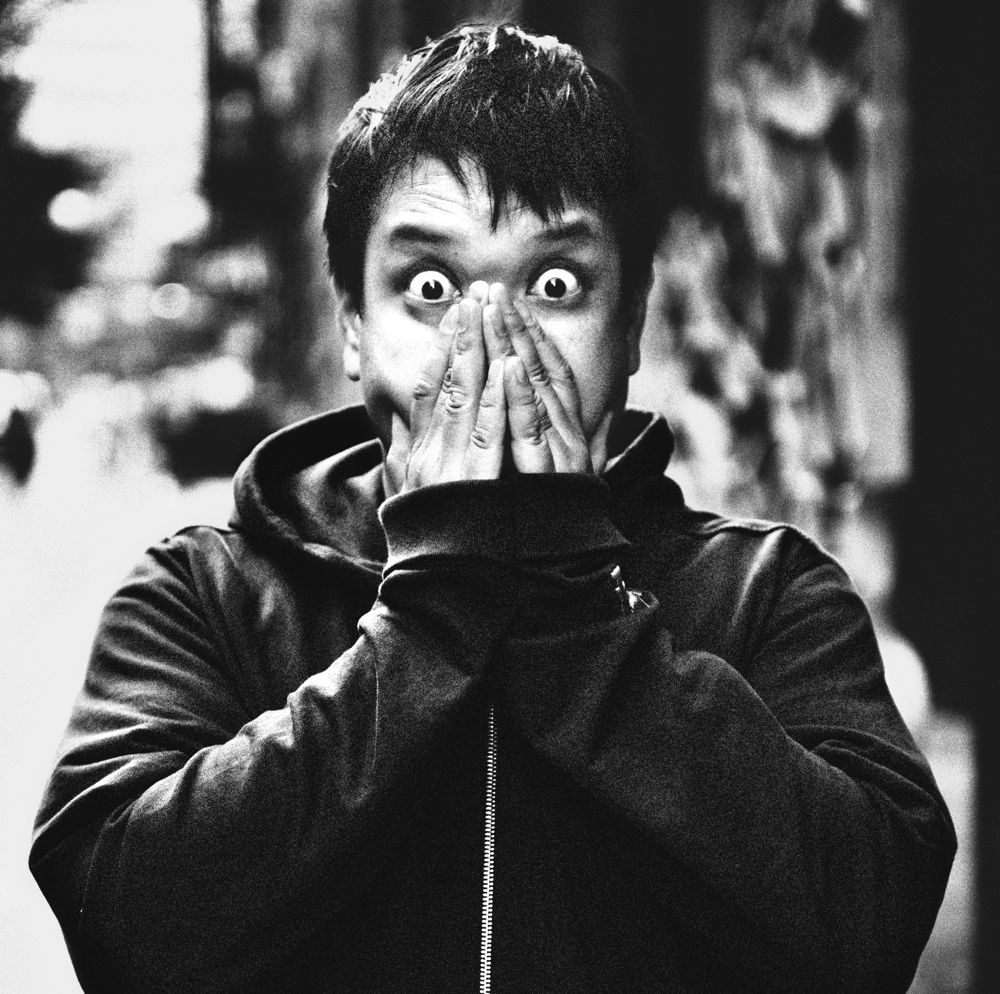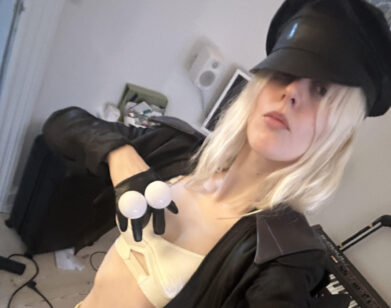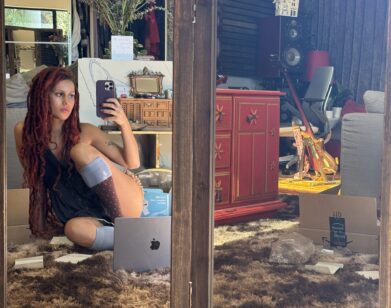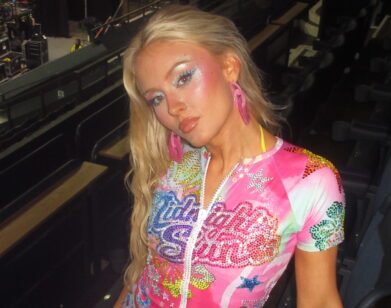Kid Koala: From Paperboy to Bluesman

ABOVE: KID KOALA IN NEW YORK, AUGUST 31, 2012. PHOTO BY CHRISTOPHER GABELLO.
Whether or not you’re aware of it, you are probably already a fan of Kid Koala. Active since the mid-’90s, the DJ, turntable artist and graphic novelist has toured with Radiohead, the Beastie Boys, and Bjork; published two books; written for the score of films such as Scott Pilgrim vs. the World; and collaborated with Handsome Boy Modeling School, Delatron 3030, and Gorillaz. Indeed, it is Koala, who provides those opening scratches on Gorillaz’s first hit, “Clint Eastwood.” He’s a long-time friend of fellow DJ Dan the Automator, and a bit of a behind-the-scenes legend.
For his fifth solo album, 12 Bit Blues, Koala tackles the blues ‘90s hip-hop style. Armed with the archaic E-mu SP-1200 drum machine and sampler—a favorite of J-Dilla, A Tribe Called Quest, and KRS-One—Koala reworks blues classics into raw, scratchy, utterly danceable, and oddly 21st century tracks. Interview recently met the enthusiastic and charming Canadian at a restaurant on the Bowery in New York.
EMMA BROWN: I heard that you got an exciting new turntable machine for this album.
KID KOALA: This actually goes back to, if you can imagine, 12-year-old me discovering hip-hop for the first time and being blown away by everything that I was hearing. I was learning about what machines were being used [and] there was one specifically called the SP-1200, which The Bomb Squad were using for the Public Enemy records, and Cypress Hill were using, and Pete Rock-all those guys. I remember going to the store and asking about it and it had a ticket price of $5000, which even is a lot by today’s standards, but at the time it was state of the art and so out of reach. I had a paper route before high school and I thought, I’m never ever going to be able to afford that.” So I took the DJ route—”I can afford these two records”—and I was just stacking and scratching It was always this sort of mystical machine but, oddly enough, your phone has more technology than 10,000 of these SP-1200s. As far as music technology is concerned, it’s the most obsolete machine you could possibly use. It loads on little three-and-a-half-inch floppy disks, it only stores about 10 seconds of sound and then the longest sound you can have is about two seconds. It has all these limitations and restrictions, but somehow, it kind of forces you to use it more directly. I think of it a little bit akin to a little blues band playing guitar and they couldn’t afford a drummer to bring along, so they would just stomp their feett to have the beat going. It’s sort of the same idea to me. This kind of machine is pointless to use, but there’s ghosts in it and I wanted to get my hands dirty and see what would come up.
BROWN: Where do you even get a floppy disk today?
KOALA: EBay. [laughs] There are like warehouses that sell the old, double-density floppy disks. That’s where you save all your sounds. It has a tone in it that acts up and seems older than I am. Sometimes it doesn’t always boot up the disk properly or the sound has weird idiosyncrasies, but I have fun playing with it.
BROWN: What was the first instrument you learned how to play?
KOALA: Piano. I started on classical when I was 4 years old. That was very strict, always preparing for competitions or exams or adjudications. It was one of those things where our teachers would hit us—well, not hard, but they’d pat your hands when your posture was bad. [laughs] It wasn’t, musically, the most exciting for me to play—it felt like, “Here’s this 500-year old track and you have to do it exactly this way. No deviation, no improvisation.” By the time I was 12 years old, I discovered turntables and it seemed like that had a totally different attitude: “Do your own thing! Try new things!” It was encouraged to try and do something fresh and something that had your personality in it.
BROWN: Can you listen to music without thinking about how you would twist it?
KOALA: No. [laughs] I think the only music I can do that [with] are the [songs] I was listening to before I started recording. A lot of music that I grew up listening to, like the classical and jazz music my parents listened to, that holds memory, nostalgia.
BROWN: Do you find listening to music exhausting then?
KOALA: No. It’s almost like there’s just a part of my brain that’s always hearing it in different contexts. “Oh, that could work in this set,” or, “This could work as a layer here. This would be the perfect thing for this animation” or something,” It’s just how my brain works—the visuals and the music are always linking themselves together.
BROWN: Do you dance?
KOALA: Do I dance? I’m a horrible dancer! Most DJs I know are. Not to get too Freudian with it, but [DJs] are kind of shy—awkward teenage years. There were kids that would go put themselves on the basketball courts—that wasn’t me. Or other kids on skateboards—also not me. Turntables, on the other hand—maybe it was because of all the piano training—was something I immediately had a connection to. It was a really mesmerizing activity and I could just practice for hours and hours and hours and not notice time go by.. Part of the goal was, “If I start DJing I’ll get invited to parties and then I won’t have to dance because I’ve got to play the record.” [laughs]
BROWN: Did you DJ at high school parties?
KOALA: I did do a couple, and I would always try to do a little routine or scratch a bit. All the sudden one of two things happened: either everyone would leave the dance floor or everyone crowd around—”Woah, what are you doing?” It was hit or miss depending on what party it was. [laughs] But it was fun. Those early days it was half juke-boxing and half self-expression. Obviously what you had in your crate was usually stuff that you were into, or at least I was.
BROWN: You’ve worked a lot with fellow DJ and turntable artist, Dan the Automator. When did you first meet?
KOALA: I met him here in New York City in 1997, I believe. He came to my first New York show. I had just signed to Ninja Tune and we were doing a North American tour and he came to my gig at Wetlands. We were introduced and we hit it off right away—it was an immediate chemistry between our musical tastes, sense of humor, and interest in food and whatever. Obviously, I was a fan of Dr. Octagonecologyst and the stuff that he had done up to that point. He needed some help stalking this girl, apparently. [laughs] He was like, “We were at this restaurant and the waitress there said she was gonna go to your show right after,” which might’ve been the reason he showed up in the first place, to see if she showed up. I remember we were looking for her. [laughs] It was sort of cute story, I guess. I wonder if he’s in touch with her. They actually dated, she was a waitress at Go Sushi or something. I digress.
BROWN: Is he how you got involved with Gorillaz?
KOALA: Yes. I still haven’t been paid for my work on Gorillaz, which is fine, I actually did it because at the time, Dan saw I was on tour in London and he called and said, “Hey, you’re in London. Come by this studio, I’m working on this thing with Damon Albarn and if you do some scratches on this record, he’ll introduce you to Björk.” That was his whole thing because I was like, “I’m kind of tired…” But I’m glad I went cause I got to meet Jamie Hewlett and Damon, of course. He’s a great dude.
BROWN: Did he introduce you to Björk?
KOALA: He never did. It’s an outstanding debt between me and Damon Albarn. [laughs] I did end up meeting Björk many years later, she actually got a copy of my book Nufonia Must Fall (2003). It was really strange series of events where Dolly Parton was supposed to open for her in Toronto, but for some reason she got sick or couldn’t get out of the country. So we got this call, I think it was at midnight, “Björk’s people just called to see if you want to open with her in Toronto,” which is an eight-hour drive, and I was like, “Oh yeah, most definitely!” I stayed up practicing all night with my turntables and band and took a little trip there. It was cool.
BROWN: Out of all the people you’ve toured with—Björk, the Beasties Boys, and Radiohead—whose fans have been the most receptive?
KOALA: I’d say Radiohead, most definitely. I’ve been listening to them since Pablo Honey, so to even have that invitation…I tried to do something that I felt, hopefully, the audience would understand. I just had a little 20-minute set to do my thing. I remember we were in Baltimore and Colin [Greenwood] and Thom [Yorke] talked to me, “Hey, we were just wondering”— they were so polite about it—”You can say no, but we were wondering if you would be interested in playing some turntables on a couple songs with us during our set?” I said, “Excuse me,” ran to another room and jumped up and down. They were like, “How about ‘National Anthem’,” which is what they used to start their concerts with, so I was actually starting the show with them. [laughs] So many Radiohead stories…[laughs]
One time they were trying to do this song called “In Limbo” and Thom said, “Something’s wrong. It’s missing something.” I was just standing on the side, I always set up on the side and check if the needles are working, it’s not that fun. [Thom] was like, “We need someone to play tambourine…Get Koala to do it. It’s really easy, you just go ‘chka-chka-cha-chka-chka-chka-cha.'” [laughs] They took Thom’s vocal mike and pointed it sort of down to where the tambourine was, so I was literally standing in the middle of the stage—this is at sound check—in front this vast space that would be filled with tens of thousands of people. I was playing tambourine and I’ve never been so embarrassed [and] self-conscious, cause normally I have a bunch of turntables to hide behind. $3000 worth of equipment is a little easier to feel comfortable behind than this little tambourine. I’m standing there right where Tom stands and I’m like, “I’m not gonna play this right here, you’ve got to set me up behind Bill [the drummer].” [laughs]. In hindsight maybe I should have just stood there. [laughs] It would’ve been, “Who’s that Chinese kid playing tambourine?”
12 BIT BLUES COMES OUT TOMORROW, SEPTEMBER 18, VIA NINJA TUNE.






